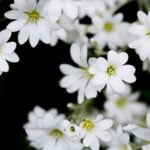Gardening in small spaces can be a rewarding and fulfilling experience, proving that you don’t need a sprawling backyard to enjoy the beauty of nature. In this article, we will delve into various gardening ideas for those with limited space, from balconies to rooftops and even indoor areas.
Whether you’re an urban dweller or simply looking to make the most of your compact living quarters, there are plenty of creative ways to bring a touch of greenery into your surroundings.
For many urban dwellers, the idea of cultivating a garden may seem like a far-fetched dream. However, small space gardening comes with its own set of unique benefits that make it ideal for those living in tight quarters.
Not only does it provide a sense of tranquility and connection to nature, but it also allows individuals to exercise their creativity and nurturing instincts. By exploring gardening ideas in small spaces, city residents can discover a newfound appreciation for plants and greenery right at their fingertips.
When it comes to small space gardening, choosing the right plants is essential for success. From herbs and succulents to compact vegetables and flowers, there are plenty of options that thrive in limited environments. Throughout this article, we will provide tips and recommendations on selecting the perfect plants for your small space garden, ensuring that you can enjoy a lush oasis no matter how constrained your living area may be.
Benefits of Gardening in Small Spaces
Urban dwellers often face the challenge of limited space when it comes to gardening. However, this constraint can actually be a blessing in disguise, as small space gardening offers a myriad of benefits for those living in cities.
One of the main advantages is that it allows individuals to enjoy the therapeutic benefits of gardening without requiring a large outdoor area. In fact, tending to plants in small spaces has been shown to reduce stress and anxiety, improve mood, and increase overall well-being.
Another benefit of small space gardening for urban dwellers is the ability to grow fresh produce right at home. With the rising interest in urban agriculture and sustainability, more and more people are turning to growing their own fruits, vegetables, and herbs.
By utilizing balconies, rooftops, or indoor spaces creatively, urban gardeners can cultivate a variety of edibles such as tomatoes, peppers, lettuce, basil, and more. Not only does this help reduce grocery expenses, but it also ensures a supply of organic and pesticide-free produce.
Moreover, small space gardening allows urban dwellers to connect with nature in the midst of a bustling city environment. Whether it’s through caring for houseplants indoors or creating a mini oasis on a balcony or rooftop, individuals can escape the concrete jungle and immerse themselves in greenery.
Additionally, incorporating sustainable practices such as composting food scraps or using rainwater for irrigation can further enhance the environmental impact of small space gardening. It truly provides a fulfilling way to nurture both plants and oneself amidst urban living.
| Benefit | Description |
|---|---|
| Therapeutic Benefits | Tending plants in small spaces reduces stress and anxiety while improving overall well-being. |
| Access to Fresh Produce | Urban gardeners can grow fruits, vegetables, and herbs at home for organic and cost-effective supply. |
| Nature Connection | Small space gardening helps urban dwellers connect with nature amidst city life by creating green spaces. |
Choosing the Right Plants for Small Space Gardening
When it comes to gardening in small spaces, choosing the right plants is essential for maximizing your limited area and ensuring a successful harvest. Whether you have a tiny balcony or a compact indoor space, selecting the appropriate plants can make all the difference. Here are some tips and recommendations to help you create a thriving small space garden:
- Consider the size of your space: Before selecting any plants, assess the amount of sunlight, water, and space available in your small area. Choose plants that will thrive in these conditions.
- Opt for compact varieties: Look for dwarf or mini versions of your favorite vegetables and fruits. These varieties are perfect for small space gardening and can be grown in pots or containers.
- Focus on multi-functional plants: Select crops that offer multiple benefits such as herbs that can be used for cooking and medicinal purposes. This way, you can make the most out of your limited space.
Small space gardening doesn’t have to limit your choices when it comes to plant selection. By carefully choosing the right plants based on your specific conditions and preferences, you can create a beautiful and productive garden even in the smallest of spaces.
- Invest in vertical garden-friendly plants: Opt for climbing fruits and vegetables like tomatoes, peas, or cucumbers that can grow upwards instead of spreading out horizontally.
- Choose low-maintenance plants: If you have limited time to dedicate to gardening, select easy-to-care-for plants like succulents, cacti, or herbs that require minimal attention but still provide visual appeal.
- Think about companion planting: Maximize your small space by planting complementary crops together. For example, grow basil with tomatoes or marigolds with vegetables to deter pests naturally.
By strategically selecting a variety of plants that suit your space constraints and personal preferences, you can create a thriving small space garden that brings joy, beauty, and bounty right to your doorstep. With these tips and recommendations in mind, you’ll be well on your way to enjoying the benefits of gardening even in the smallest of spaces.
Creative Container Gardening Ideas for Limited Spaces
Container gardening is a fantastic way to bring life and color to small spaces, whether you have a tiny balcony, patio, or even just a windowsill. With a little creativity and the right plant choices, you can create a beautiful mini garden in almost any nook or cranny. Here are some creative container gardening ideas for limited spaces:
- Repurpose items: Get creative with containers by using items you already have around the house like old buckets, mason jars, tin cans, or even shoes. Just make sure they have proper drainage holes at the bottom.
- Vertical gardening: Utilize vertical space by hanging containers on walls or fences. Vertical gardens not only save space but also add visual interest to your small outdoor area.
- Stacked planters: Stack different-sized pots on top of each other to create a tiered effect. This not only saves space but also allows you to grow multiple plants in one area.
When choosing plants for your container garden in a small space, consider the amount of sunlight your location receives and the size of the plant at maturity. Herbs like basil, mint, and rosemary are great options for kitchen windowsills, while flowers like petunias, pansies, and marigolds add color to balconies. Don’t be afraid to mix and match different plants to create a diverse and visually appealing garden.
Incorporating container gardening into your small space is not only aesthetically pleasing but also offers numerous benefits such as improved air quality, reduced stress levels, and access to fresh herbs or vegetables. So get your hands dirty, unleash your creativity, and start transforming your limited space into a lush green oasis with these gardening ideas in small spaces.
Vertical Gardening Solutions for Maximizing Space
Vertical gardening is a fantastic way to make the most of limited space and create a lush, green oasis in even the smallest of areas. By utilizing walls, fences, or other vertical structures, you can expand your gardening possibilities and enjoy a variety of plants without sacrificing precious square footage.
One popular method of vertical gardening is installing a trellis or lattice on a wall to support climbing plants like vines, tomatoes, or cucumbers. This not only adds visual interest but also allows you to grow more plants in the same area.
Another creative vertical gardening solution is using hanging planters or shelves to create a living wall display. These can be placed indoors or outdoors and are perfect for growing herbs, succulents, or small flowering plants. Vertical planters come in various sizes and styles, making it easy to customize based on your space and aesthetic preferences. Additionally, incorporating a vertical garden provides better air circulation around plants, which can help prevent diseases and pest infestations commonly found in traditional gardens.
When planning your vertical garden, consider the amount of sunlight your chosen location receives throughout the day. Different plants have varying light requirements, so it’s essential to select species that will thrive in your specific conditions. Whether you’re beautifying a balcony, courtyard, or even an office cubicle, incorporating vertical gardening into your small space can transform it into a green paradise while maximizing every inch available.
| Benefits of Vertical Gardening | Tips for Success |
|---|---|
| Maximizes space usage | Choose lightweight materials for vertical structures |
| Creates visual interest | Ensure proper drainage for hanging planters |
| Increases air circulation around plants | Regularly water and fertilize as needed |
Making Use of Balconies and Rooftops for Gardening
Gardening in small spaces can be a challenge, but with some creativity and resourcefulness, even the tiniest of spaces like balconies and rooftops can be transformed into lush green oases. When it comes to making use of balconies and rooftops for gardening, there are several key factors to consider in order to make the most of your limited space.
Maximizing Space Efficiency
One of the first considerations when setting up a garden on a balcony or rooftop is maximizing space efficiency. Utilizing vertical space by incorporating hanging planters, wall-mounted trellises, and shelving units can help make the most of every inch. Additionally, using compact varieties of plants and vegetables that don’t spread out too much can also help maximize space efficiency.
Choosing the Right Plants
Selecting the right plants for balcony or rooftop gardening is crucial for success. Opt for plants that are well-suited to container growth, such as herbs, lettuces, dwarf fruit trees, succulents, and ornamental grasses. Consider the amount of sunlight your balcony or rooftop receives throughout the day and choose plants accordingly to ensure they thrive in their environment.
Creative Design Ideas
Get creative with your balcony or rooftop garden design by incorporating elements such as colorful containers, decorative planters, hanging light fixtures, and outdoor rugs to create an inviting space. Consider adding seating options like bistro sets or lounge chairs to transform your garden into a cozy retreat where you can relax and unwind amidst nature.
By implementing these tips and ideas for making use of balconies and rooftops for gardening, urban dwellers can enjoy the benefits of gardening in small spaces while adding beauty and greenery to their homes. Whether you have a tiny balcony or a spacious rooftop terrace, there are endless possibilities for creating a vibrant garden oasis that brings joy and tranquility into your daily life.
Tips for Successful Indoor Gardening in Small Spaces
When it comes to gardening in small spaces, indoor gardening can be a creative and fulfilling way to bring greenery into your home. Whether you live in an apartment or have limited outdoor space, indoor gardening allows you to cultivate plants and herbs all year round. Here are some tips for successful indoor gardening in small spaces:
Choose the Right Plants
One of the keys to successful indoor gardening in small spaces is selecting the right plants that thrive indoors. Look for houseplants that don’t require a lot of natural light, such as snake plants, pothos, and spider plants. Herbs like mint, basil, and parsley also do well indoors and can easily be grown on your kitchen windowsill.
Provide Adequate Light
Since natural light may be limited indoors, it’s important to supplement with artificial light sources to ensure your plants receive enough sunlight. Consider investing in grow lights or placing your plants near a south-facing window where they can get sufficient sunlight throughout the day.
Proper Watering and Drainage
Overwatering is a common issue with indoor plants, so make sure to water your plants only when the soil is dry to the touch. Ensure that your pots have drainage holes to prevent water from accumulating at the bottom and causing root rot. Consider using self-watering pots or trays to help regulate moisture levels.
By following these tips for successful indoor gardening in small spaces, you can create a thriving mini oasis inside your home. Indoor gardening not only adds beauty to your living space but also provides mental health benefits through connecting with nature. So whether you’re growing herbs in your kitchen or adding tropical plants to your bedroom, there are endless possibilities for creating a lush indoor garden even in the smallest of spaces.
Incorporating Sustainable Practices Into Small Space Gardening
Incorporating sustainability practices into small space gardening is not only beneficial for the environment, but it can also help you create a more self-sufficient and resilient garden. One important aspect of sustainable gardening in small spaces is to focus on reducing waste and conserving resources.
Consider using compost bins or vermicomposting to recycle organic kitchen waste into nutrient-rich soil for your plants. This practice not only reduces landfill waste but also provides your garden with essential nutrients without the need for chemical fertilizers.
Additionally, water conservation is crucial in small space gardening, especially when dealing with limited outdoor space. Utilize rain barrels to collect rainwater for watering your plants, or opt for drought-resistant plants that require less water. Another sustainable practice is to avoid using pesticides and instead opt for natural pest control methods like planting companion plants that deter pests or introducing beneficial insects to your garden.
Furthermore, incorporating sustainable practices into small space gardening can extend beyond just the plants themselves. Consider repurposing old containers for planting, using eco-friendly materials for DIY projects in your garden, or even upcycling items to create functional and aesthetic elements in your outdoor oasis. By adopting these sustainable practices, you can create a thriving and environmentally conscious small space garden that brings joy and beauty to your surroundings.
Case Studies
To truly appreciate the potential of gardening in small spaces, it is helpful to look at real-life examples of individuals who have successfully created lush and vibrant gardens in limited areas. One such inspiring case study is that of Sarah, a busy city dweller with a passion for plants but limited outdoor space.
By utilizing vertical gardening solutions and creative container ideas, Sarah transformed her small balcony into a verdant oasis filled with herbs, flowers, and even a small vegetable patch. Her innovative approach not only maximized her space but also brought beauty and tranquility into her urban lifestyle.
Another compelling example is the community garden project initiated by a group of neighbors living in an apartment complex. With no access to traditional gardening plots, they decided to collaborate and transform the building’s rooftop into a shared garden space.
Through careful planning and sustainable practices, such as composting and rainwater harvesting, they were able to cultivate a variety of crops and ornamental plants. This collective effort not only provided fresh produce for the residents but also fostered a sense of community spirit and shared responsibility for the environment.
Indoor gardening in small spaces can also yield impressive results when approached with creativity and dedication. Take the case of Mark, a plant enthusiast living in a studio apartment with minimal sunlight exposure. Undeterred by these challenges, Mark researched low-light tolerant plants and invested in grow lights to create an indoor oasis filled with lush greenery.
His commitment to nurturing his indoor garden not only improved the air quality in his living space but also enhanced his overall well-being. These case studies serve as powerful reminders that with some ingenuity and determination, anyone can enjoy the beauty and benefits of gardening in small spaces.
Conclusion
In conclusion, gardening in small spaces offers a plethora of benefits and creative opportunities for urban dwellers looking to bring nature into their homes. With the right plants, containers, and vertical solutions, anyone can create a beautiful and thriving garden in limited spaces. From balconies to rooftops, there are endless possibilities for exploring gardening ideas in small spaces.
As seen in the case studies provided, real-life examples showcase the potential of small space gardens to transform even the most compact areas into lush green sanctuaries. By incorporating sustainable practices into your gardening routine, you can not only beautify your space but also contribute positively to the environment.
I encourage readers to take inspiration from this article and start their own small space gardens. Whether you’re a beginner or an experienced gardener, there are resources available to guide you in cultivating your mini oasis. With a bit of creativity and dedication, you too can enjoy the therapeutic joys of gardening in even the smallest of spaces. So go ahead, dive into the world of gardening ideas in small spaces and watch your indoor or outdoor sanctuary flourish.
Frequently Asked Questions
How Do You Garden in a Small Space?
Gardening in a small space requires creativity and strategic planning. Vertical gardening with trellises or hanging planters can maximize space. Container gardening is also a great option, using pots or raised beds to grow plants efficiently.
How Do You Make a Small Garden Beautiful?
Making a small garden beautiful involves careful selection of plants and decorations. Choose a color scheme that complements the space, incorporate various textures, and add elements like decorative stones or artwork to create visual interest. Regular maintenance is key to keeping it looking its best.
What Is the Best Layout for a Vegetable Garden?
The best layout for a vegetable garden depends on factors like sunlight exposure, soil quality, and available space. Consider organizing plants based on their height and water needs, grouping together those with similar requirements for optimal growth. Raised beds or square foot gardening can also help maximize productivity in limited space.

Welcome to my gardening blog! I am passionate about plants and enjoy sharing my knowledge and experiences with others. In this blog, I will write about everything related to gardening, from tips on how to get started to updates on my own garden projects.





